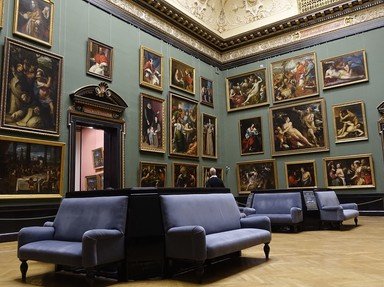Quiz Answer Key and Fun Facts
1. We begin our tour with "The Crucifixion", a work from the 1580s. This is one of the last paintings by a Late-Mannerist/Italian Renaissance artist who is best-known for large historical paintings of both religious and mythological subjects. Who is the artist?
2. Our next masterpiece, "Portrait of Baldassare Castiglione", is a work from 1514-15. This is one of the last works by a painter who died young. An artist whose work we have seen elsewhere on our travels, he is another Italian painter. Who is this artist, one of the great masters of the High Renaissance period?
3. Our next artist is another Italian, this time from the Florentine Renaissance. Michelangelo was one of the many apprentices who studied at his workshop. The pictured work, "Visitation", was painted in 1491, just three years before his death. Who is the artist?
4. Painted around 1440, "The Annunciation" is the central panel from a triptych by one of the most important Early Netherlandish painters. Altarpieces make up most of the surviving work who, during his lifetime, was famous throughout Europe. Who is this artist?
5. Completed between 1669-70, the tiny (9.6"x8.3") "The Lacemaker" is the smallest work painted by a Dutch artist who is renowned for his scenes of middle-class life in the 17th century. Although only moderately successful during his lifetime, he is now widely considered one of the greatest painters of the Dutch Golden Age. Who is this artist?
6. "The Fortune Teller" is a 1594 oil on canvas. This is an early work by an Italian artist who not only had a profound influence on the Baroque style, but is also responsible for some of Rome's best-known altarpieces. That he left such a large body of work is remarkable for one who led such a turbulent and short life: he died in mysterious circumstances aged just 38. Who is this artist?
7. "Portrait of the Infanta Maria Margareta" is a 1655 work by a leading Baroque artist and one of the greatest of all portrait painters. He is known particularly for his portraits of the Spanish royal family as well as other European nobles. Who is this artist?
8. Painted in 1839, the miniature (10"x15") "Hunting Dogs" is a beautiful example of work by a French artist who could command a whole room at The Louvre, as there are 26 of his paintings in the collection. Having travelled widely in the East, many of his paintings reflect scenes from those cultures and he is known as the "Founding Founder of Orientalism". Who is this artist?
9. Our next exhibit is "King Charles I at the Hunt", a 1635 painting by another artist with more than 20 works in The Louvre collection. This Flemish Baroque artist enjoyed success in both Flanders and Italy before traveling to England, where he became the principal court painter to the English monarch. Who is this artist?
10. We finish this tour with "The Shepherds of Arcadia", a 1640 work by an artist who has 40 paintings in the Louvre collection. Although he spent much of his life in Rome, he is still considered one of the leading classical French Baroque artists. Known for his historical paintings, many with a biblical or mythological theme, he was one of the first artists to include significant aspects of landscape in his work. Who is this artist?
Source: Author
EnglishJedi
This quiz was reviewed by FunTrivia editor
looney_tunes before going online.
Any errors found in FunTrivia content are routinely corrected through our feedback system.
